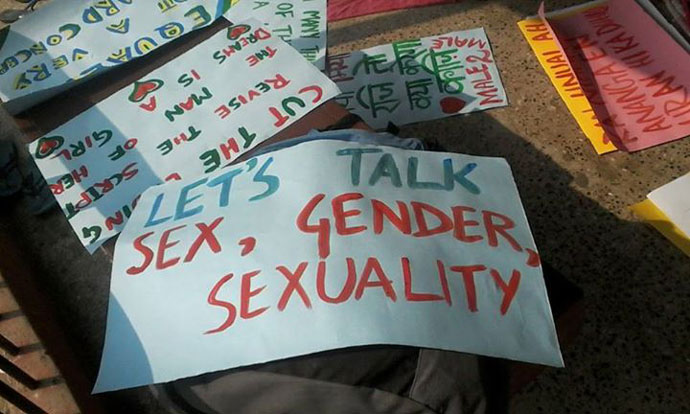As Delhi fights for rights on Valentine's Day, Northeast hosts its second queer pride parade

"She had the swagger of a girl. She blushed like a boy. She had a girl's toughness. She had a boy's gentleness. She was as meaty as a girl. She was as graceful as a boy... She made love like a boy. She made love like a girl."
- Ali Smith, Girl Meets Boy.
As some of us struggled with freedom of expression on Valentine's Day, at the Delhi abode of the Hindu Mahasabha, back in the Northeast, students and activists were colouring their masks to walk the region's second queer pride parade. The states of the Northeast joined hands for raising the rainbow flag high. Last year, the pride parade began its baby steps with the support of AIDS activist and social worker Jahnabi Goswami, demanding to abolish the Section 377 of IPC. Today, it is important to question the norm that queerness has become and to think beyond the label of LGBTQ, to compel the state to withdraw its dictatorial interference in our personal lives. The participants believe that the meaning of the pride parade needs to extend itself beyond the queer ethos: We need to mobilise a space for historically marginalised people. Along with this, they are also collaborating, inviting assistance from youth organisations to take up the cause of freedom of romantic expression. One wonders the fate of movements like these in a society driven by problems associated with identity, militancy, ethnicity among others. Remember, no "cause" can distance itself from other social injustices of its era.
"No revolution comes in isolation," said Bitopi Dutta, one of the founders of the Xukia Queer Collective. "History telling has been mostly an exclusive and heterosexist one; hence we are keen on negotiating with the people's movements to move beyond the normative knowledge based discourse. We are also condemning violence of all kinds, even violent struggles that kept the region in fear last December. In terms of appreciating alternative and marginalised sexualities, we are trying to reflect on our grassroots and pay more attention to the grey areas from there."
In the medieval times, as many scholarly works have pointed out, there were richer possibilities of utilising these grey areas. But the colonial history of the Northeast left its imprints on people's personal lives and this is a history that we cannot deny. In fact, in Assam, the caste system created a class of Brahmins who placed sexual repression at the heart of the society while simultaneously tolerating the worship of liminal/other deities for their sexual prowess.
A friend from JNU, who took part in this year's Delhi queer pride parade, opines on this matter, "The shift from rural to urban was also responsible in the imbibing of some confusing ideals of colonial modernity. No scope was left to explore subversive/queer spaces in earlier traditions like the plays of Manipur (Shumung-Lila), Assam (Bhaona) where cross-dressing laid the ground for socio-political messages."
 |
| Banners from the Northeast Queer Pride Parade 2015. |
It would be a mistake to attribute timelessness to hetero-normative history, as often done by most fundamentalist thinkers. The place from where the NE pride started Dighalipukhuri (literally a long pool) presents us with a paradox. For the previous generation, this was a popular spot for lovers. The pool was supposedly dug for Duryodhana and Bhagadatta's daughter Bhanumati's wedding bath. Today, if you are to so much as sit for a cup of coffee in Dighalipukhuri park with your partner, you would become the subject of continuous indoor surveillance. Perhaps it would be a perfect feed for some regional news channels that thrive on sexual taboos and shockingly regressive programming.
In such a scenario, poetry and writings in regional languages can be healing. The NE Queer Collective has received a host of poems from the neighbouring states, including slogans in Mizo ("Kannihna ah hriatthiamnakanmamawh", "Duhtak a siamleh din kanni"), Naga, Bodo, etc. The pride began from Dighalipukhuri to Guwahati High Court and covered some of the "normative" cultural places like Rabindra Bhavan. To say that alternative sexualities are doubly marginalised in the Northeast would be a cliché, so we ought to look into agency that can fight back as well. Some of the transgender performances today asserted this agency.
She sang, "Bhalo beshe shokhi...",
And basked in the caress
Of her love, her princess.
The other now sang,
"Drink to me only with thine eyes...",
And felt the warmth of
Her lover's skin.
Those deep caresses,
About which poets have written
Since decades and decades to be,
Finally met its epoch.
Those silent soundings of stares,
Brought forth the life of
Two women in love.
They lived together -
On Earth,
And in the unseen play of souls
Down the eroding soil,
In the hushes of winds,
And in the breeze
That flowed the stream...
- Satyaki Chakraborty.
Bitopi is optimistic about the future of the queer movement. "The city police have been cooperative as of now, though we keep receiving threat calls from time to time. There are volunteers from Guwahati University, Cotton College, Handique College, etc who have helped us with the organisation of the event. Compared to last year, the responses are positive: people from Mumbai and Kolkata have also arrived for the pride parade. Perhaps this will help us move a step beyond the victim narrative of queerness and of the Northeast."

